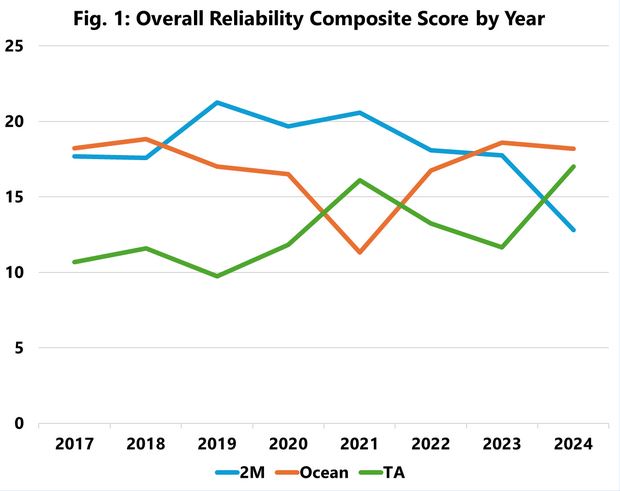The current three-alliance structure in container shipping has been in place since April 2017, when Ocean Alliance and THE Alliance launched alongside the already existing 2M alliance. After nearly 8 years of operations, February 2025 will bring about a new alliance structure, according to Sea-Intelligence.
During this 8-year period, the trends in schedule reliability have changed considerably. That said, schedule reliability can be hard to contextualise over longer periods of time, which is why Sea-Intelligence created a composite score for each year these alliances have been in operation.
The way this score was calculated was as follows: for each trade lane that the alliances were operational in, we calculated how many months each alliance ranked 1st, 2nd, or 3rd in terms of schedule reliability. These numbers were then multiplied by 3, 2, and 1, for 1st, 2nd, and 3rd, respectively. The total for each year is shown in Figure 1.

In both 2017 and 2018, Ocean Alliance was the most consistent carrier alliance in terms of schedule reliability, followed closely by 2M, with THE Alliance lagging considerably. In 2019 and 2020, 2M and Ocean Alliance switched places, whereas in 2021, Ocean Alliance dropped below even THE Alliance.
In 2024, Ocean Alliance has once again regained the top spot, and THE Alliance has seen a significant resurgence in schedule reliability, elevating it to the second spot. 2M was the least consistent carrier alliance in terms of schedule reliability in 2024.
Overall, across the entire alliance life cycle of the current alliance structure so far (2017-2024), 2M was the most consistent in terms of schedule reliability, with the highest composite score. They were ranked 1st in 49% of the instances, and 2nd in 31% of the instances. Ocean Alliance was the next most-reliable carrier alliance, having been 1st in 36% of the instances, and 2nd in 39% of the instances. THE Alliance only managed to come out on top in 15% of the instances and was 2nd in 31% of the instances.



